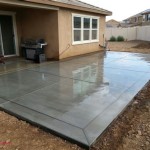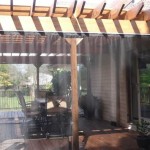Outdoor Flagstone Patio Ideas: A Comprehensive Guide
Flagstone patios offer a timeless appeal and a natural aesthetic that blends seamlessly with outdoor environments. The irregular shapes, varied textures, and earthy tones of flagstone create a unique and visually appealing surface for patios, walkways, and other outdoor living spaces. This article explores various flagstone patio ideas, covering design considerations, material selection, installation techniques, and maintenance tips to help homeowners create a beautiful and durable outdoor retreat.
Design Considerations for Flagstone Patios
Careful planning is crucial to ensuring a successful flagstone patio project. Several design factors should be considered before beginning the installation process. These considerations will influence the final look and functionality of the patio area.
Patio Size and Shape: The size and shape of the patio should be determined based on the intended use of the space. A small patio may be suitable for a cozy seating area, while a larger patio can accommodate outdoor dining, lounging, and entertaining. Consider the overall layout of the yard and how the patio will integrate with existing landscaping features. Irregular shapes often complement the natural look of flagstone, but geometric patterns can also be achieved with careful planning and cutting.
Traffic Flow and Accessibility: The design should consider the flow of traffic to and from the patio. Ensure that there are clear pathways to other areas of the yard, such as the house, garden, or pool. Consider accessibility for individuals with mobility challenges, ensuring that the surface is relatively even and that any steps or changes in elevation are properly addressed. Ramps or gradual slopes can enhance accessibility and improve the overall usability of the patio.
Integration with Existing Landscaping: A flagstone patio should complement the existing landscaping and architectural style of the home. Consider the colors and textures of surrounding plants, trees, and building materials. Incorporate plants and landscaping elements into the patio design to create a seamless transition between the patio and the surrounding landscape. Raised planting beds, container gardens, and strategically placed trees can enhance the aesthetic appeal and create a more inviting outdoor space.
Drainage: Proper drainage is essential to prevent water from accumulating on the patio surface. Ensure that the patio is sloped slightly away from the house to allow water to drain effectively. Consider installing drainage solutions, such as French drains or permeable pavers, to manage excess water and prevent erosion. Standing water can lead to the growth of mold and mildew, damage the flagstone, and create a hazardous environment.
Material Selection for Flagstone Patios
Flagstone is a sedimentary rock that is available in a variety of colors, textures, and thicknesses. Choosing the right type of flagstone is essential for achieving the desired aesthetic and ensuring the durability of the patio.
Types of Flagstone: Common types of flagstone include sandstone, limestone, quartzite, and slate. Each type has its own unique characteristics and properties. Sandstone is known for its warm colors and textured surface. Limestone is a more porous stone that is available in a range of colors, including gray, beige, and brown. Quartzite is a hard and durable stone that is resistant to weathering and abrasion. Slate is a fine-grained stone that is available in dark colors, such as black, gray, and green. The choice of flagstone will depend on the desired aesthetic, budget, and environmental conditions.
Color and Texture: The color and texture of the flagstone should complement the surrounding landscape and architectural style of the home. Consider the colors of the house, roof, and surrounding landscaping when selecting flagstone. The texture of the flagstone can also affect the overall look and feel of the patio. Smooth flagstone is more comfortable to walk on, while textured flagstone provides better traction and a more rustic look. Mixing different colors and textures of flagstone can create a visually interesting and unique patio surface.
Thickness and Size: The thickness of the flagstone should be determined based on the intended use of the patio and the type of base material used. Thicker flagstone is more durable and can withstand heavier loads, making it suitable for high-traffic areas. Thinner flagstone is less expensive and easier to work with, but it may not be as durable. The size of the flagstone pieces will affect the installation process and the overall look of the patio. Larger pieces of flagstone create a more formal and uniform look, while smaller pieces create a more informal and rustic look.
Quantity and Cost: Calculate the amount of flagstone needed based on the size of the patio and the desired spacing between the stones. It is always a good idea to order extra flagstone to account for breakage and waste during installation. The cost of flagstone can vary depending on the type of stone, thickness, and availability. Obtain quotes from multiple suppliers to ensure that the best price is obtained. Consider the cost of delivery and installation when budgeting for the project.
Installation Techniques for Flagstone Patios
Proper installation is essential to ensuring the longevity and stability of a flagstone patio. Several techniques can be used to install flagstone, depending on the desired look and the type of base material used.
Preparation: Before beginning the installation process, the area should be properly prepared. Remove any existing vegetation, topsoil, and debris. Excavate the area to the desired depth, taking into account the thickness of the base material and the flagstone. Compact the subsoil to create a stable foundation. Proper preparation is essential to prevent settling and cracking of the patio surface.
Base Material: A well-drained base is essential for supporting the flagstone and preventing water from accumulating beneath the patio. Common base materials include gravel, crushed stone, and sand. The thickness of the base material will depend on the type of soil and the intended use of the patio. A thicker base is required for heavy clay soils or high-traffic areas. Compact the base material in layers to create a firm and level surface.
Setting the Flagstone: Flagstone can be set using several methods, including dry-laid, mortar-set, and polymeric sand. A dry-laid patio involves setting the flagstone directly on a compacted base of sand or gravel. This method is relatively easy and inexpensive, but it may not be as durable as other methods. A mortar-set patio involves setting the flagstone in a bed of mortar. This method creates a more permanent and stable patio surface, but it requires more skill and experience. Polymeric sand is a mixture of sand and polymers that hardens when wetted. This method is a good compromise between dry-laid and mortar-set, providing a stable and durable patio surface with minimal effort.
Cutting and Shaping: Flagstone often needs to be cut and shaped to fit properly within the patio design. A masonry saw or hammer and chisel can be used to cut flagstone. When cutting flagstone, wear safety glasses and gloves to protect from flying debris. Experiment with different patterns and arrangements of the flagstone to achieve the desired look. The gaps between the flagstone pieces should be relatively uniform and filled with sand, gravel, or mortar, depending on the installation method.
Joint Filling: After the flagstone has been set, the joints between the stones should be filled. For dry-laid patios, the joints can be filled with sand or gravel. Sweep the sand or gravel into the joints and compact it with a tamper. For mortar-set patios, the joints should be filled with mortar. Apply the mortar evenly and smooth it with a trowel. For polymeric sand patios, apply the polymeric sand to the joints and wet it with water to activate the polymers. Allow the polymeric sand to dry completely before walking on the patio.
Maintenance and Care for Flagstone Patios
Regular maintenance and care are essential to preserving the beauty and durability of a flagstone patio. Proper maintenance can prevent damage from weathering, erosion, and staining, extending the life of the patio.
Cleaning: Flagstone patios should be cleaned regularly to remove dirt, debris, and stains. Sweep the patio regularly to remove loose debris. Wash the patio with a garden hose and mild detergent to remove dirt and grime. For stubborn stains, use a pressure washer with a low-pressure nozzle. Avoid using harsh chemicals or abrasive cleaners, as they can damage the flagstone. Consider using a specialized stone cleaner designed for flagstone surfaces.
Sealing: Sealing flagstone can help protect it from staining, weathering, and water damage. A sealant forms a barrier that prevents water and other liquids from penetrating the stone. Apply a sealant according to the manufacturer's instructions. Reapply the sealant every few years to maintain its effectiveness. Choose a sealant that is specifically designed for the type of flagstone used in the patio.
Weed Control: Weeds can grow in the joints between the flagstone pieces, detracting from the beauty of the patio. Regularly remove weeds by hand or with a garden tool. Apply a weed killer to prevent weed growth. Choose a weed killer that is safe for use around plants and pets. Consider using polymeric sand in the joints to prevent weed growth.
Winter Protection: In cold climates, flagstone patios can be damaged by freezing and thawing. Prevent water from accumulating on the patio surface by ensuring proper drainage. Avoid using de-icing salts, as they can damage the flagstone. Consider covering the patio with a tarp or protective cover during the winter months.
Repair: Over time, flagstone can crack, chip, or become loose. Repair any damage promptly to prevent further deterioration. Replace any cracked or broken flagstone pieces with new ones. Re-level any loose flagstone pieces by adding more base material beneath them. Re-fill any eroded joints with sand, gravel, or mortar.
By following these design considerations, material selection guidelines, installation techniques, and maintenance tips, homeowners can create a beautiful and durable flagstone patio that enhances the value and enjoyment of their outdoor living space. A well-designed and properly maintained flagstone patio will provide years of enjoyment and create a welcoming retreat for family and friends.

39 Best Flagstone Patio Designs Pictures Design Pebble

Flagstone Patio Ideas Cost How To Install Landscaping Network

14 Flagstone Patio Ideas To Enhance Your Yard S Natural Beauty

Flagstone Patio Ideas Cost How To Install Landscaping Network

Flagstone Patio Ideas The Perfect Outdoor Space Design

5 Easy Diy Landscaping Ideas With Flagstone K2 Stone

Flagstone Patio Ideas Cost How To Install Landscaping Network

Natural Flagstone Patio Fire Pit Stone Backyard

8 Ways To Use Flagstone In Your Landscaping Lawnstarter

25 Great Stone Patio Ideas
Related Posts








